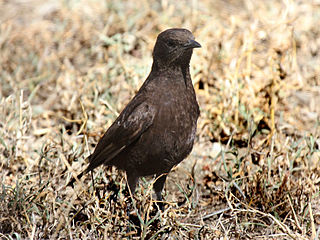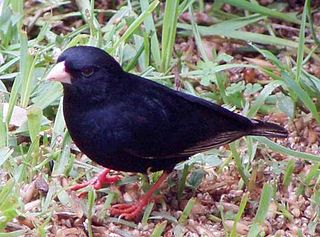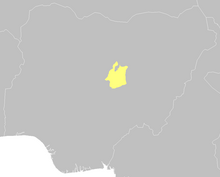
The indigobirds and whydahs, together with the cuckoo-finch, make up the family Viduidae; they are small passerine birds native to Africa.

The red-billed firefinch or Senegal firefinch is a small seed-eating bird in the family Estrildidae. This is a resident breeding bird in most of Sub-Saharan Africa with an estimated global extent of occurrence of 10,000,000 km2. It was introduced to Egypt, but the population there has become extinct. It was also introduced to southern Algeria where it is currently expanding northward.

The village indigobird, also known as the steelblue widowfinch or the Combassou finch, is a small songbird belonging to the family Viduidae. It is distinguishable from other indigobird species by bill and leg colours, the colour tinge of the male's breeding plumage, song, and to lesser extent, the nestling's plumage and mouth pattern. The bill colour can be red or white depending on the population, and there is some regional variation in the colour tone of the male's plumage.

The Jos Plateau is a plateau located near the centre of Nigeria. The plateau has given its name to the Plateau State in which it is found and is named for the state's capital, Jos. The plateau is home to people of diverse cultures and languages. The plateau's montane grasslands, savannas, and forests are home to communities of plants and animals distinct from those of the surrounding lowlands and constitute the Jos Plateau forest-savanna mosaic ecoregion.

The long-tailed paradise whydah or eastern paradise whydah is from the family Viduidae of the order Passeriformes. They are small passerines with short, stubby bills found across Sub-Saharan Africa. They are mostly granivorous and feed on seeds that have ripen and fall on the ground. The ability to distinguish between males and females is quite difficult unless it is breeding season. During this time, the males molt into breeding plumage where they have one distinctive feature which is their long tail. It can grow up to three times longer than its own body or even more. Usually, the whydahs look like ordinary sparrows with short tails during the non-breeding season. In addition, hybridization can occur with these paradise whydahs. Males are able to mimic songs where females can use that to discover their mate. However, there are some cases where females don't use songs to choose their mate but they use either male characteristics like plumages or they can have a shortage of options with song mimicry. Paradise whydahs are brood parasites. They won't destroy the eggs that are originally there but will lay their own eggs in other songbirds nest. Overall, these whydahs are considered least concerned based on the IUCN Red List of threatened species.

The African firefinch, also called the dark firefinch or blue-billed firefinch due to the color of its bill, is a common species of estrildid finch found in almost all parts of Africa. It has an estimated global extent of occurrence of 5,400,000 km2 (2,100,000 sq mi).

The rock firefinch is a species of estrildid finch found in the Jos Plateau of central Nigeria and in Cameroon. It has an estimated global extent of occurrence of 29,000 km2. The rock firefinch was discovered recently, in 1998. Rock firefinches fall in the family Estrildidae, which contains small passerine birds of the Old World and Australasia. Rock firefinches seem to be most closely related to Mali firefinches and Chad firefinches. The species name sanguinodorsalis means blood-red back, which was chosen because it describes the vibrant red back color of the male plumage. The status of the species is evaluated as Least Concern.

The wildlife of Nigeria consists of the flora and fauna of this country in West Africa. Nigeria has a wide variety of different habitats, ranging from mangrove swamps and tropical rainforest to savanna with scattered clumps of trees. About 290 species of mammal and 940 species of bird have been recorded in the country.

The cuckoo-finch, also known as the parasitic weaver or cuckoo weaver, is a small passerine bird now placed in the family Viduidae with the indigobirds and whydahs. It occurs in grassland in Africa south of the Sahara. The male is mainly yellow and green while the female is buff with dark streaks. The eggs are laid in the nests of other birds.

The anteater chat or northern anteater-chat is a species of bird in the family Muscicapidae.It is found in Burkina Faso, Cameroon, Central African Republic, Chad, Gambia, Kenya, Mali, Mauritania, Niger, Nigeria, Senegal, Sudan, and Tanzania. Its natural habitats are dry savanna, subtropical or tropical dry lowland grassland, and subtropical or tropical high-altitude grassland.

The dusky indigobird, variable indigobird, or black widowfinch is a species of bird in the family Viduidae. It is found in Angola, Burundi, Cameroon, Republic of the Congo, Democratic Republic of the Congo, Eswatini, Guinea-Bissau, Malawi, Mozambique, Nigeria, Sierra Leone, South Africa, Tanzania, Zambia, and Zimbabwe. Its natural habitat is moist savanna.

The exclamatory paradise whydah or Uelle paradise whydah is a species of bird in the family Viduidae. It is also known as the long-tailed paradise whydah, a name which can refer to Vidua paradisaea.
The barka indigobird is a species of bird in the family Viduidae. It is found in Cameroon, Ethiopia, Gambia, Ghana, Guinea, Nigeria, Sudan, and South Sudan. It is also known as the baka indigobird but the spelling "barka" is more correct; the word is a greeting in the Hausa language.

The purple indigobird is a species of bird in the family Viduidae. It is also known as the dusky indigobird, a name which can refer to Vidua funerea. It is found in Angola, Botswana, Democratic Republic of the Congo, Kenya, Malawi, Mozambique, South Africa, Tanzania, Zambia, and Zimbabwe. Its natural habitat is dry savanna.
The jambandu indigobird is a species of bird in the family Viduidae. It is also known as the goldbreast indigobird. It is found in Benin, Burkina Faso, Cameroon, Central African Republic, Ghana, Guinea, Ivory Coast, Liberia, Nigeria, Sierra Leone, South Sudan and Togo. Its habitat is savannah and brush.
Wilson's indigobird or the pale-winged indigobird, is a species of bird in the family Viduidae. It is found in Cameroon, Central African Republic, Chad, Republic of the Congo, Democratic Republic of the Congo, Ivory Coast, Ghana, Guinea, Guinea-Bissau, Nigeria, Senegal, South Sudan, and Togo.
The Cameroon indigobird is a species of bird in the family Viduidae. It is considered by some authors to be a subspecies of the variable indigobird. They range from Sierra Leone to east Cameroon, north east Zaire and South Sudan.
The quailfinch indigobird is a small songbird. It is a resident breeding bird in The Gambia, Nigeria and Cameroon. It occurs in isolated localities, especially on river flood plains.

The Sahel paradise whydah, yellow-naped whydah or northern paradise whydah is a small songbird.















